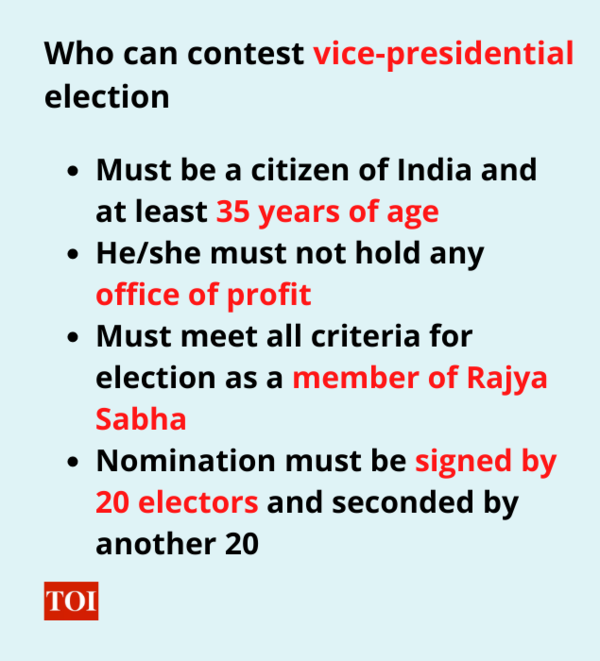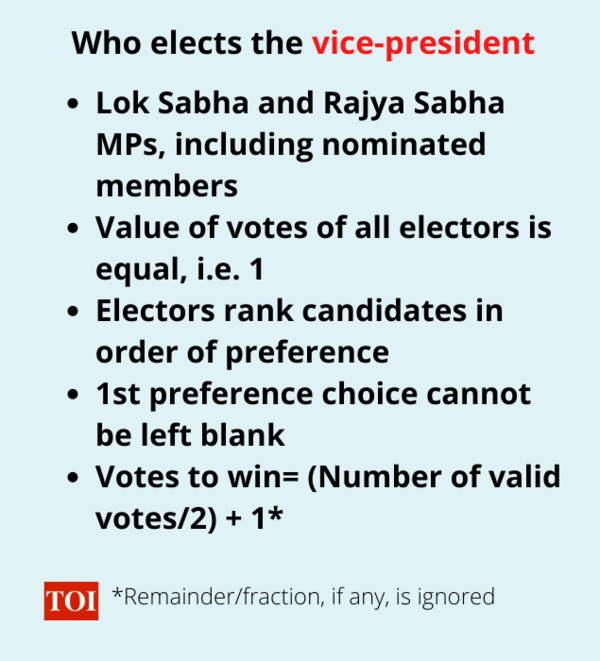
Vice Presidential Election today: All you need to know | India News
[ad_1]
Dhankhar is contesting against opposition candidate Margaret Alvawho served as Union minister in several Congress-led governments.
The term of incumbent M Venkaiah Naidu ends on August 10.
The Election Commission had announced the schedule for the vice-presidential election on June 29. Voting will be held in the Parliament House, and counting will be conducted the same day.
Here’s all you need to know about Saturday’s vice-presidential election.
Office of the Vice-President of India
It is the second-highest constitutional office after the president. The vice-president is also the ex officio chairman of the Rajya Sabha.
Who can become Vice-President of India?
To be elected vice-president, one needs to be a citizen of India, at least 35 years of age and must not hold any office of profit.
He also must meet all criteria for election as a member of the Rajya Sabha.
What is the nomination process?
The nomination of a candidate needs to be endorsed by at least 20 electors, and seconded by another 20.
Candidates are required to deposit a security amount of Rs 15,000 with the RBI.

Who votes to elect the vice-president?
The Vice President is elected by the members of the Electoral College consisting of the members of both Houses of Parliament in accordance with the system of proportional representation by means of a secret, single transferable vote.
The Electoral College comprises of a total of 788 MPs (233 elected and 12 nominated members of Rajya Sabha, 543 elected members of Lok Sabha). However with 8 vacancies in the Rajya Sabha, a maximum of 780 votes could be cast this time.
Unlike in presidential election, nominated members of Parliament too can vote to elect the vice-president. However members of state legislatures do not vote.
Political parties cannot issue whip to their MPs.
Where is the election and counting to be held?
Polling will take place in Room No. 63 on the 1st floor of the Parliament House on August 6, between 10am-5pm. Counting will take place the same day.
What is the value of an individual elector’s vote?
Since all the electors are members of Parliament, the value of vote of each MP is equal, i.e. 1.
How is the winner decided?
The electors rank the candidates in fray in an order of preference. While the marking of the first preference is compulsory for the ballot paper to be valid, other preferences are optional.
The number of votes required to win is calculated by dividing the total number of valid cast votes by two, plus one (ignoring remainder, if any).

If no candidate obtains the required number of first-preference votes, the candidate with the fewest first-preference votes is eliminated and his/her second-preference votes are transferred. The process is repeated until a candidate obtains the requisite number of votes.
The story so far
Sarvepalli Radhakrishnan took oath as India’s first vice-president on May 13, 1952. Since then, India has seen 12 more vice-presidents.
Radhakrishnan along with Hamid Ansari share the distinction of having served more than one term.
Most number of vice-presidents (5) were elected to office as Congress nominees, followed by BJP (2).
[ad_2]
Source link


